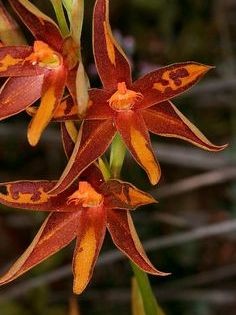Tiger orchid
(Thelymitra tigrina)

Description
Thelymitra tigrina, commonly called the tiger orchid or tiger sun orchid, is a species of orchid that is endemic to the south-west of Western Australia. It has a single narrow leaf and up to fifteen small yellow flowers with small brown spots. Thelymitra tigrina is a tuberous, perennial herb with a single leaf 100–150 mm (4–6 in) long and 3–4 mm (0.1–0.2 in) wide. Between two and fifteen yellow, cup-shaped flowers with many dark brown spots, 10–16 mm (0.4–0.6 in) wide are borne on a flowering stem 150–700 mm (6–30 in) tall. The sepals and petals are 5–8 mm (0.2–0.3 in) long and 3–5 mm (0.1–0.2 in) wide. The column is a similar colour to the sepals and petals, 3–4 mm (0.12–0.16 in) long, about 2 mm (0.08 in) wide and has short, white, pimply arms on the sides. The lobe on top of the anther is short and covered with small bumps. The flowers are self-pollinated and open on hot, sunny days. Flowering occurs from November to January. Thelymitra tigrina was first formally described in 1810 by Robert Brown and the description was published in Prodromus Florae Novae Hollandiae et Insulae Van Diemen. The specific epithet (tigrina) is a Latin word meaning "of tigers", referring to the colour of the flowers. The tiger orchid grows in dense scrub in near-coastal, winter-wet scrub. It is found between Perth and Albany with a disjunct population near Esperance. Thelymitra tigrina is classified as "not threatened" in Western Australia by the Western Australian Government Department of Parks and Wildlife. Thelymitra, commonly known as sun orchids, is a genus of more than 100 species of plants in the orchid family, Orchidaceae. Unlike most other orchids, sun orchids lack a highly modified labellum and all three petals are similar in size, shape and colour. The column is, however, highly modified and usually has prominent wings or glands which are helpful in identifying the species. Most sun orchids close their flowers at night, in cloudy or cool weather, giving rise to their common name. The scientific name means "woman's hood" and refers to the hooded column present in most, but not all species. Most species are endemic to Australia although some are found as far from there as the Philippines and Indonesia. The type species, Thelymitra longifolia, the first to be formally described, was collected in New Zealand.
Taxonomic tree:







